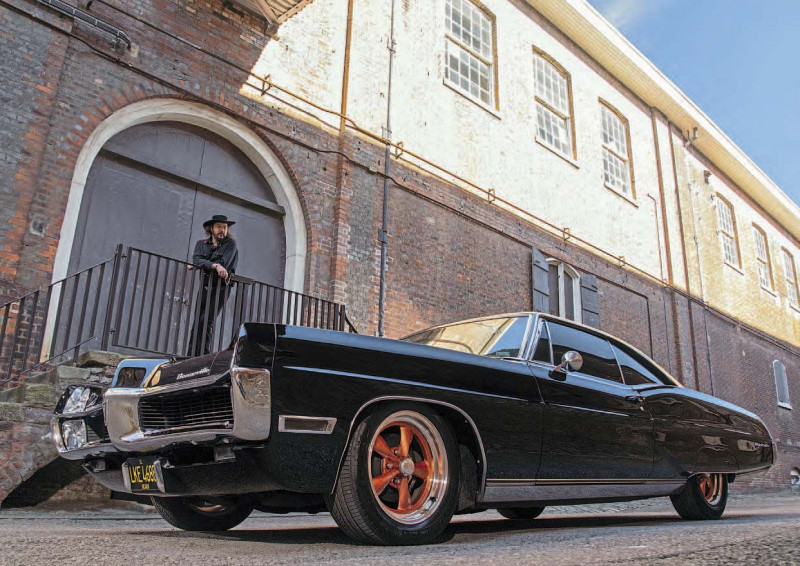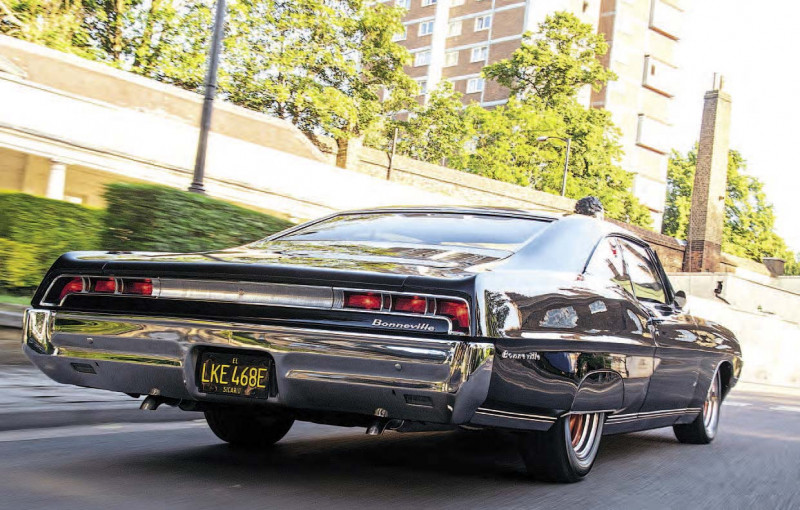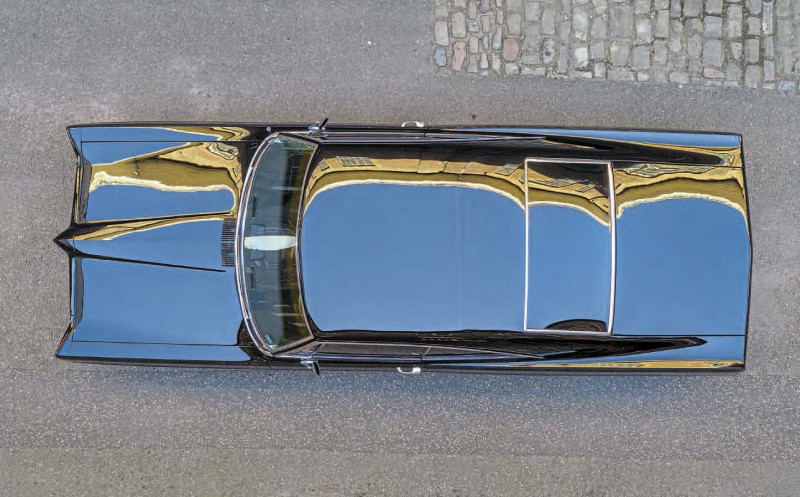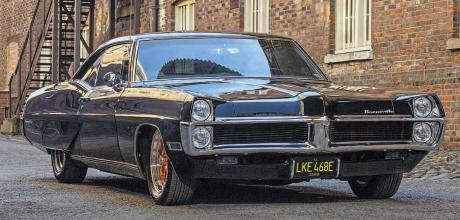1967 Pontiac Bonneville
Trevor Cowell’s big black Pontiac really is an imposing machine, but this ’67 Bonneville needed a little bit of personalization. Words: Mike Renaut. Photography: Matt Richardson.
El Sicario
Trevor Cowell doesn’t go around assassinating bad guys for the mafia so far as we know but, should he ever decide to, he has the perfect car for the job with this mean, shiny black 1967 Pontiac Bonneville. We featured Trevor’s white 1958 Cadillac in our October 2019 issue but the Bonneville had joined his fleet a year earlier in October 2018 after Trevor spotted it on eBay. “I’ve always had a soft spot for the ‘67 Bonneville,” explains Trevor, “whenever I saw one in a film or at a show, it stuck in my mind. This one was initially for sale on the south coast and as I debated buying it, the car got sold. Later, it turned up for sale again, this time a lot nearer to me in Bromley.”

The seller was Lenny Lucas, whose 1970 Challenger 440 we featured back in 2016: “I didn’t know Lenny then, but we’ve stayed in touch and swapped a few bits back and forth. Lenny tends to change his cars often, so this time I jumped at the chance to own the Bonneville.” The Pontiac was extremely low mileage, but not perfect. “It has 21,000 miles showing and, having now been all over the car, I’m sure that’s genuine,” continues Trevor. “It was in nice condition, but obviously had sat unused for a while and needed recommissioning. The HT leads were hard as concrete; I managed to snap one completely in half. I drove the car home from Lenny’s in the rain with the brakes not feeling quite right and decided the first job was a thorough service.”
Benefiting from the fully equipped workshop at his business, TJ Motors (01883 730170/www. tjmotorslimpfield.co.uk), where he works on classic, American and modern vehicles, Trevor went completely through the Bonneville. “It was completely stock with everything numbers-matching. It still had factory date-coded parts – the carburettor and alternator were date stamped. The chrome was decent; I suspect the bumpers have been redone, and it had been repainted at some point in the original black − I believe, when it first came to the UK.

“I removed the dashboard and repainted the lower half, rebuilt the broken clock and converted the radio to FM, added an iPod connection and got the speaker fader operating correctly. I then got the air conditioning working too, converting it to modern gas. The vinyl seats got a good clean – a centre console and front bucket seats appear to be unusual on a 1967 Bonneville – I’ve not seen another. The interior was generally good and I had my trimmer do the boot to match.
“I pulled out the engine and painted the block, mixing the paint by eye to get the closest Pontiac blue I could. I also tidied and painted the engine bay. I fitted new brake hoses, both the water and fuel pumps were leaking so they were replaced; the fuel pump with an electric one. The Pontiac got new brake cylinders, a new master cylinder and new shocks all round too. It was wonderful to work on, everything on the car was original and clean, no threaded bolts; it came apart like a brand-new car.

“I don’t have any history though. Lenny bought it from someone in the UK and I think it came into the country via a car dealer in America, so whether the original owner died and then it sat in his garage, I’m not sure.”
At some point, a previous owner found the Bonneville’s build sheet – one of several pieces of paper fixed to the car that told the factory workers which parts to fit as it went along the assembly line. From that, we can tell the Bonneville was built at the Kansas City Plant around the middle of March 1967, then shipped by truck to Ferguson Buick-Pontiac GMC in Houston.
It was built with tinted glass, deluxe front and rear seatbelts, bucket seats (costing $114 extra), front power driver’s seat, reclining passenger seat ($84), cornering lamps ($34), headrests, air conditioning (a $421 option), centre console ($105), power brakes, passenger vanity mirror, power steering (from $94), tilt column, deluxe steering wheel, the L78 400cu in V8, Turbo Hydra-Matic transmission and deluxe wheel covers.
Luxury going fast
Pontiac introduced the Bonneville in the 1957 model year. Named after the famous Utah salt flats used for racing and land speed record attempts, that first-year Bonneville was a luxury convertible in the Star Chief model range. The 1958 Bonneville was now a separate model, with a Sport Coupe joining the convertible, although much of that previous luxury was now extra-cost options. Then, for 1959, a four-door Vista hardtop was added. Bonneville remained the luxury model above Catalina and Star Chief with a Bonneville Custom four-door wagon appearing in 1961.
The introduction of the Grand Prix in 1962 meant there were now four separate models – Catalina, Star Chief, Bonneville and Grand Prix − using essentially the same body but different interior and exterior trim, with upmarket Bonnevilles and Grand Prix traditionally riding a slightly longer wheelbase.
While the new GTO was grabbing most of the headlines, the 1965 models also saw a complete redesign of the full-size Pontiacs. They retained their vertical headlights and trademark split grille while adding hidden windscreen wipers and wider ‘Coke bottle’ hips, which not only looked good on sporty two-door models but really suited the big wagons too. These were ‘personal luxury cars’ rather than outright muscle cars, but after Motor Trend got their 421cu in Catalina test car to 60mph in eight seconds, they declared it their Car of the Year: “Docile as a kitten in town, it went wild when we put our foot down,” explained the tester. Underneath was a new, full perimeter chassis shared with other full-size GM B-bodies, offering far better side impact protection than the previous X-frame, while the new Turbo Hydra-Matic transmission replaced the previous Roto version.
The 1967 Pontiacs were introduced on September 29, 1966, with advertising urging customers to ‘Ride the Wide- Track Winning Streak.’ For ’67, the Star Chief model became the Executive, while the Bonneville could be had with all the Executive features such as electric clock, deluxe steering wheel and wheel covers, but also boasted tail-lights with three individual lenses, along with sill and rear-panel accent mouldings.
Trevor’s Bonneville is one of 31,016 two-door hardtops sold for 1967 with a factory price (before options) of $3227. Of the 96,708 Bonnevilles built that model year, only 278 had manual transmissions and there were an additional 6771 Bonneville wagons, just 29 of which had manual transmissions. New for ’67 were engine choices of the 400cu in V8 with 333bhp (325 for manual gearbox cars), a 360-horse 428cu in V8 or an HO (High Output) 428.
Orange on the new black
Despite it being a low-mileage original, Trevor needed to make a few improvements to his Bonneville. “The original 14-inch wheels just looked too small so I bolted on some 17-inch Rockets. But I didn’t want the original grey finish left on the wheels – they looked too off-the-shelf. My painter suggested this pearlescent copper paint. Several years later, I’m still in love and in hate with the colour. I was a bit restricted by choice of wheels and tyres since I’d also lowered the car two inches using custom-built coil springs all round, and it’s tough finding good aftermarket wheels that fit the Pontiac’s PCD. Although, at least it doesn’t have those eight-bolt lugs where you can only use the correct Pontiac rims. I’ve considered adding a copper accent along the side of the car but haven’t done it yet. At least you see less of the wheels now it’s lower,” laughs Trevor.
“I also added new rear-light lenses and slightly tinted them; all the bulbs have been updated to LEDs. The exhaust was a single-pipe system so that was swapped over to dual exhausts. The car came with a modern hot rod-style steering wheel which I replaced with a correct Pontiac one. I wanted a few changes but nothing that would destroy the originality so it could easily be put back to factory stock; just swap the wheels and the springs, peel off the window tint and you’d have a completely original-looking Bonneville again.”
One interesting piece is the inspection light mounted on the passenger side inner fender. “It illuminates when the bonnet is opened. At first, I thought it was just a static light but there’s about four feet of wire and you can see all around the engine. It works especially well at night since it’s 21-watt and very bright. “It’s just a car that catches the eye; the stacked headlights shared between the bumper and the body look like it shouldn’t work, but it does. I love the swage line coming up from the rear wheels and the fenderskirts adding to the length of the car. In fact, everything about the Pontiac is lovely, it’s like sitting in an armchair and it floats along like it’s on air. At 90mph it’s still one finger on the steering wheel. The steering is spot-on, the brakes are great, it’s torquey and just pulls and pulls.
“And whenever anyone asks how many bodies I can get in the boot, I look them up and down slowly and say, ‘there’s always room for one more…’”
“I LOVE THE SWAGE LINE COMING UP FROM THE REAR WHEELS AND THE FENDERSKIRTS ADDING TO THE LENGTH OF THE CAR. IN FACT, EVERYTHING ABOUT THE PONTIAC IS LOVELY,”
Long and low, just the way Harley Earl liked ’em. Vent window crank. Bonne only has 21k miles on the clock! Hard-wearing vinyl interior looks great after half a century. Yep, there’s air con too! Seventeen-inch copper finish wheels not for the shy and retiring! That’s real wood trim. Handsome dash. See this in your rear mirror? Be afraid… be very afraid! Poncho’s Bonne was a family favourite in the 60s! Full-size fun for all.


